The document discusses separating semantics from presentation in HTML using CSS. It introduces CSS and how it can be used to apply styles through external and embedded style sheets. It covers CSS syntax including selector strings and rule cascading. It also covers CSS properties related to fonts, text formatting, box model, backgrounds, normal flow layout, and positioning elements outside the normal flow.






























































































